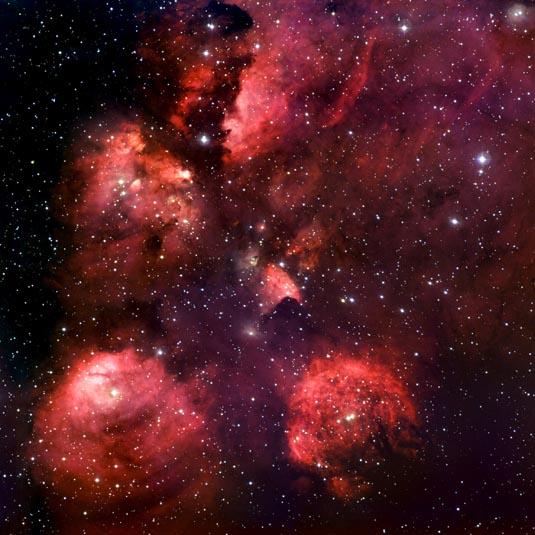
Nebula
RA 17h 19m 58s Dec. -35° 57' 47?
Scorpius
5500 light years
ESO
January 20, 2010
ESO 392-EN 009, Sharpless 8, RCW 127, Gum 64
ABOUT THIS IMAGE:
ESO has just released a stunning new image of the vast cloud known as the Cat's Paw Nebula or NGC 6334. This complex region of gas and dust, where numerous massive stars are born, lies near the heart of the Milky Way galaxy, and is heavily obscured by intervening dust clouds.
Few objects in the sky have been as well named as the Cat's Paw Nebula, a glowing gas cloud resembling the gigantic paw print of a celestial cat out on an errand across the Universe. British astronomer John Herschel first recorded NGC 6334 in 1837 during his stay in South Africa. Despite using one of the largest telescopes in the world at the time, Herschel seems to have only noted the brightest part of the cloud, seen here towards the lower left.
NGC 6334 lies about 5500 light-years away in the direction of the constellation Scorpius (the Scorpion) and covers an area on the sky slightly larger than the full Moon. The whole gas cloud is about 50 light-years across. The nebula appears red because its blue and green light are scattered and absorbed more efficiently by material between the nebula and Earth. The red light comes predominantly from hydrogen gas glowing under the intense glare of hot young stars.
NGC 6334 is one of the most active nurseries of massive stars in our galaxy and has been extensively studied by astronomers. The nebula conceals freshly minted brilliant blue stars - each nearly ten times the mass of our Sun and born in the last few million years. The region is also home to many baby stars that are buried deep in the dust, making them difficult to study. In total, the Cat's Paw Nebula could contain several tens of thousands of stars.
Particularly striking is the red, intricate bubble in the lower right part of the image. This is most likely either a star expelling large amount of matter at high speed as it nears the end of its life or the remnant of a star that already has exploded.
This new portrait of the Cat's Paw Nebula was created from images taken with the Wide Field Imager (WFI) instrument at the 2.2-metre MPG/ESO telescope at the La Silla Observatory in Chile, combining images taken through blue, green and red filters, as well as a special filter designed to let through the light of glowing hydrogen.